Comprehensive Analysis of Big Data: Techniques, Challenges & Benefits
VerifiedAdded on 2023/06/07
|8
|2004
|366
Report
AI Summary
This report provides a detailed overview of big data, its characteristics, and the challenges associated with its analysis. It covers the increasing volume of data, the importance of velocity, value, variety, and veracity in big data. The report discusses various big data analytics techniques such as A/B testing, data fusion and integration, data mining, and machine learning, highlighting how these techniques help organizations in risk management, product innovation, improving customer experience, and enhancing decision-making. It also addresses the challenges in big data analytics, including the failure to provide timely insights, inaccurate analytics due to poor data quality, and the complexities involved in its use, emphasizing the importance of proper data sources and system functionality. Desklib provides access to this solved assignment and other resources for students.
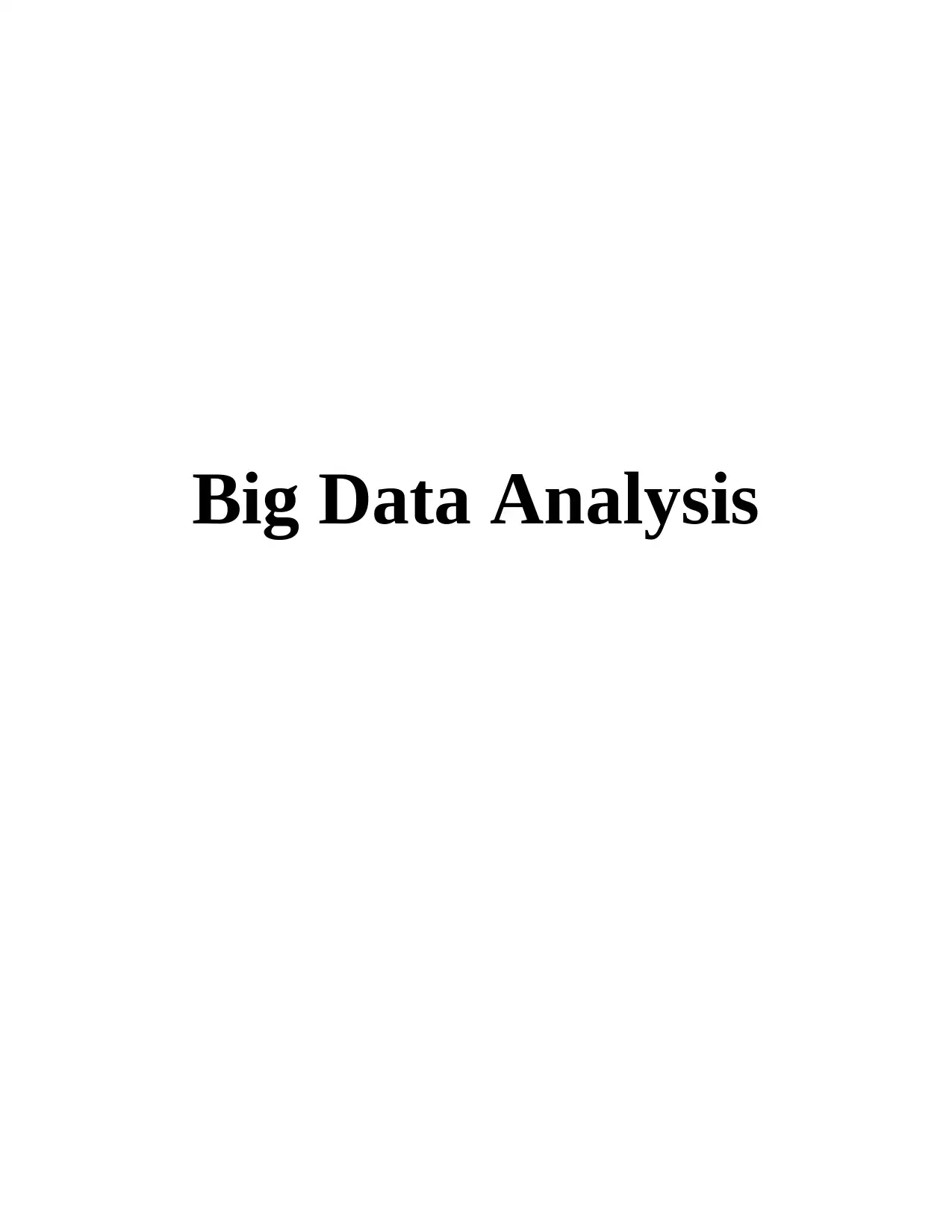
Big Data Analysis
Paraphrase This Document
Need a fresh take? Get an instant paraphrase of this document with our AI Paraphraser

Table of Contents
INTRODUCTION...........................................................................................................................3
Big Data...........................................................................................................................................3
Characteristics of big data-bases.................................................................................................3
Big data analytics........................................................................................................................4
Challenges of big data analytics..................................................................................................4
Techniques used to analyse big data...........................................................................................5
How big data analytical techniques help organization................................................................6
CONCLUSION................................................................................................................................6
References........................................................................................................................................7
INTRODUCTION...........................................................................................................................3
Big Data...........................................................................................................................................3
Characteristics of big data-bases.................................................................................................3
Big data analytics........................................................................................................................4
Challenges of big data analytics..................................................................................................4
Techniques used to analyse big data...........................................................................................5
How big data analytical techniques help organization................................................................6
CONCLUSION................................................................................................................................6
References........................................................................................................................................7
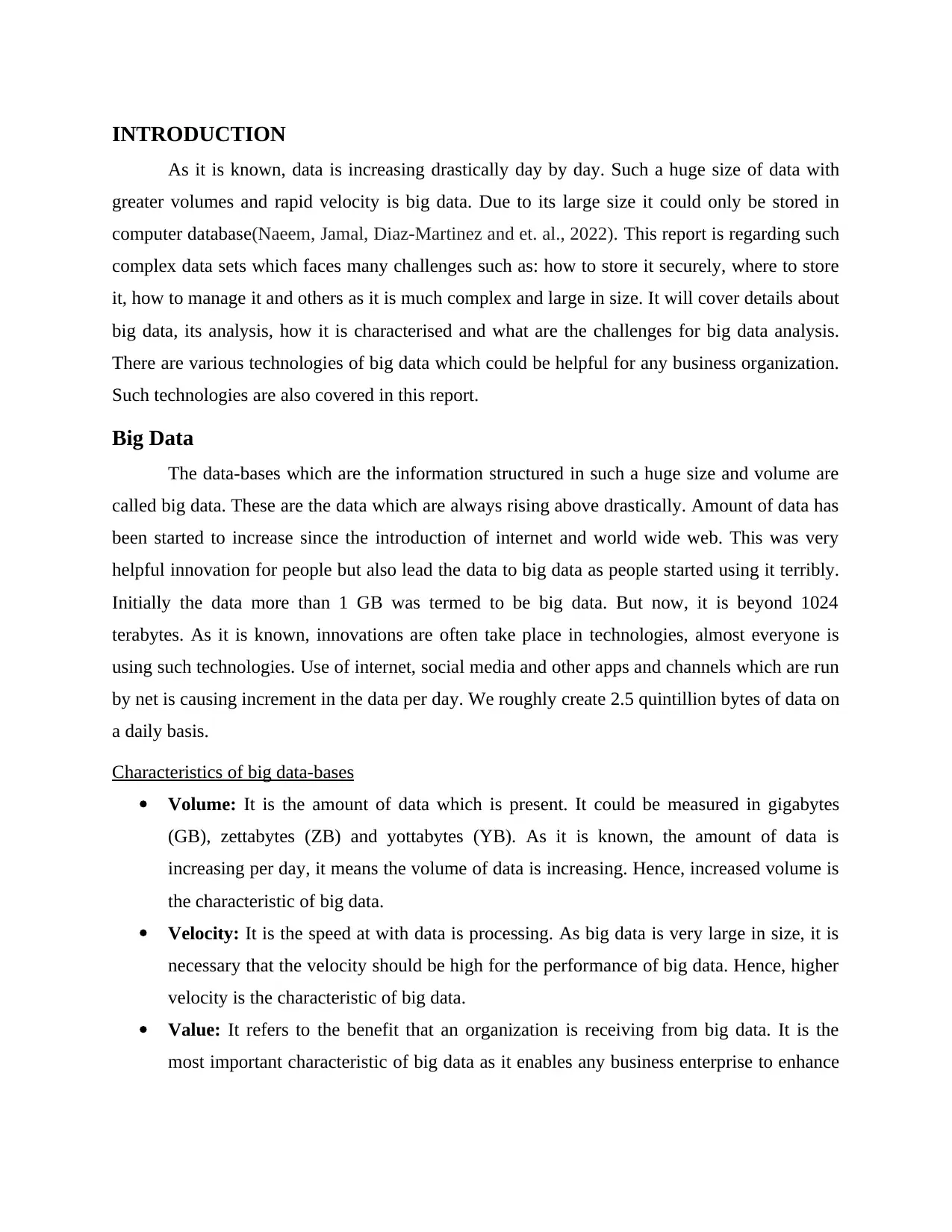
INTRODUCTION
As it is known, data is increasing drastically day by day. Such a huge size of data with
greater volumes and rapid velocity is big data. Due to its large size it could only be stored in
computer database(Naeem, Jamal, Diaz-Martinez and et. al., 2022). This report is regarding such
complex data sets which faces many challenges such as: how to store it securely, where to store
it, how to manage it and others as it is much complex and large in size. It will cover details about
big data, its analysis, how it is characterised and what are the challenges for big data analysis.
There are various technologies of big data which could be helpful for any business organization.
Such technologies are also covered in this report.
Big Data
The data-bases which are the information structured in such a huge size and volume are
called big data. These are the data which are always rising above drastically. Amount of data has
been started to increase since the introduction of internet and world wide web. This was very
helpful innovation for people but also lead the data to big data as people started using it terribly.
Initially the data more than 1 GB was termed to be big data. But now, it is beyond 1024
terabytes. As it is known, innovations are often take place in technologies, almost everyone is
using such technologies. Use of internet, social media and other apps and channels which are run
by net is causing increment in the data per day. We roughly create 2.5 quintillion bytes of data on
a daily basis.
Characteristics of big data-bases
Volume: It is the amount of data which is present. It could be measured in gigabytes
(GB), zettabytes (ZB) and yottabytes (YB). As it is known, the amount of data is
increasing per day, it means the volume of data is increasing. Hence, increased volume is
the characteristic of big data.
Velocity: It is the speed at with data is processing. As big data is very large in size, it is
necessary that the velocity should be high for the performance of big data. Hence, higher
velocity is the characteristic of big data.
Value: It refers to the benefit that an organization is receiving from big data. It is the
most important characteristic of big data as it enables any business enterprise to enhance
As it is known, data is increasing drastically day by day. Such a huge size of data with
greater volumes and rapid velocity is big data. Due to its large size it could only be stored in
computer database(Naeem, Jamal, Diaz-Martinez and et. al., 2022). This report is regarding such
complex data sets which faces many challenges such as: how to store it securely, where to store
it, how to manage it and others as it is much complex and large in size. It will cover details about
big data, its analysis, how it is characterised and what are the challenges for big data analysis.
There are various technologies of big data which could be helpful for any business organization.
Such technologies are also covered in this report.
Big Data
The data-bases which are the information structured in such a huge size and volume are
called big data. These are the data which are always rising above drastically. Amount of data has
been started to increase since the introduction of internet and world wide web. This was very
helpful innovation for people but also lead the data to big data as people started using it terribly.
Initially the data more than 1 GB was termed to be big data. But now, it is beyond 1024
terabytes. As it is known, innovations are often take place in technologies, almost everyone is
using such technologies. Use of internet, social media and other apps and channels which are run
by net is causing increment in the data per day. We roughly create 2.5 quintillion bytes of data on
a daily basis.
Characteristics of big data-bases
Volume: It is the amount of data which is present. It could be measured in gigabytes
(GB), zettabytes (ZB) and yottabytes (YB). As it is known, the amount of data is
increasing per day, it means the volume of data is increasing. Hence, increased volume is
the characteristic of big data.
Velocity: It is the speed at with data is processing. As big data is very large in size, it is
necessary that the velocity should be high for the performance of big data. Hence, higher
velocity is the characteristic of big data.
Value: It refers to the benefit that an organization is receiving from big data. It is the
most important characteristic of big data as it enables any business enterprise to enhance
⊘ This is a preview!⊘
Do you want full access?
Subscribe today to unlock all pages.

Trusted by 1+ million students worldwide

itself and achieve the desired goals. Hence, big data is characterised as very high value
for businesses.
Variety: It refers to the various forms in which big data is available. Big data is
characterised as a huge variety as there are various sources from where data is generated
such as: social media, other online media, information of various people at such
platforms and others. This will be the reason of availability of big data in such a huge
variety.
Veracity: It refers to the accuracy of available data. The more the size of data more less
will be its accuracy. Big data is characterised with low veracity as it is tough to maintain
its accuracy due to such a huge size.
Big data analytics
It is the use of analytical technique to help businesses in getting insights from present
data resources. It includes various forms of data which is against such techniques such as:
structured, semi-structured or unstructured from different sources and in different size. It
analyses data to discover hidden patterns, associations and other perceptions(Mittal, 2020). It is
used by companies to improve: performance, decision-making and competitive advantage.
Challenges of big data analytics
1. It failed to provide new insights timely: Sometimes it is difficult to get new and
accurate data at time. This may occurred due to following reason:
Lack of data: If the analytics does not have sufficient amount of data, it may cause
the lack of integration of data. This may result in poor insight supply as weak
integration result in lack of data.
Long data response: It may occur if the system is not working properly in processing
the received data insights. In such case, data is received but could not be used it is just
stored.
Old approaches to a new system: If the system is updated but still the received
information is in the old form then it could be a difficulty to process that insight. It is
a major issue which is often faced by businesses(Naeem, Jamal, Diaz-Martinez and
et. al., 2022).
2. Inaccurate analytics: There may be improper analytics and it may be worst for
businesses. This may occur due to following reasons:
for businesses.
Variety: It refers to the various forms in which big data is available. Big data is
characterised as a huge variety as there are various sources from where data is generated
such as: social media, other online media, information of various people at such
platforms and others. This will be the reason of availability of big data in such a huge
variety.
Veracity: It refers to the accuracy of available data. The more the size of data more less
will be its accuracy. Big data is characterised with low veracity as it is tough to maintain
its accuracy due to such a huge size.
Big data analytics
It is the use of analytical technique to help businesses in getting insights from present
data resources. It includes various forms of data which is against such techniques such as:
structured, semi-structured or unstructured from different sources and in different size. It
analyses data to discover hidden patterns, associations and other perceptions(Mittal, 2020). It is
used by companies to improve: performance, decision-making and competitive advantage.
Challenges of big data analytics
1. It failed to provide new insights timely: Sometimes it is difficult to get new and
accurate data at time. This may occurred due to following reason:
Lack of data: If the analytics does not have sufficient amount of data, it may cause
the lack of integration of data. This may result in poor insight supply as weak
integration result in lack of data.
Long data response: It may occur if the system is not working properly in processing
the received data insights. In such case, data is received but could not be used it is just
stored.
Old approaches to a new system: If the system is updated but still the received
information is in the old form then it could be a difficulty to process that insight. It is
a major issue which is often faced by businesses(Naeem, Jamal, Diaz-Martinez and
et. al., 2022).
2. Inaccurate analytics: There may be improper analytics and it may be worst for
businesses. This may occur due to following reasons:
Paraphrase This Document
Need a fresh take? Get an instant paraphrase of this document with our AI Paraphraser
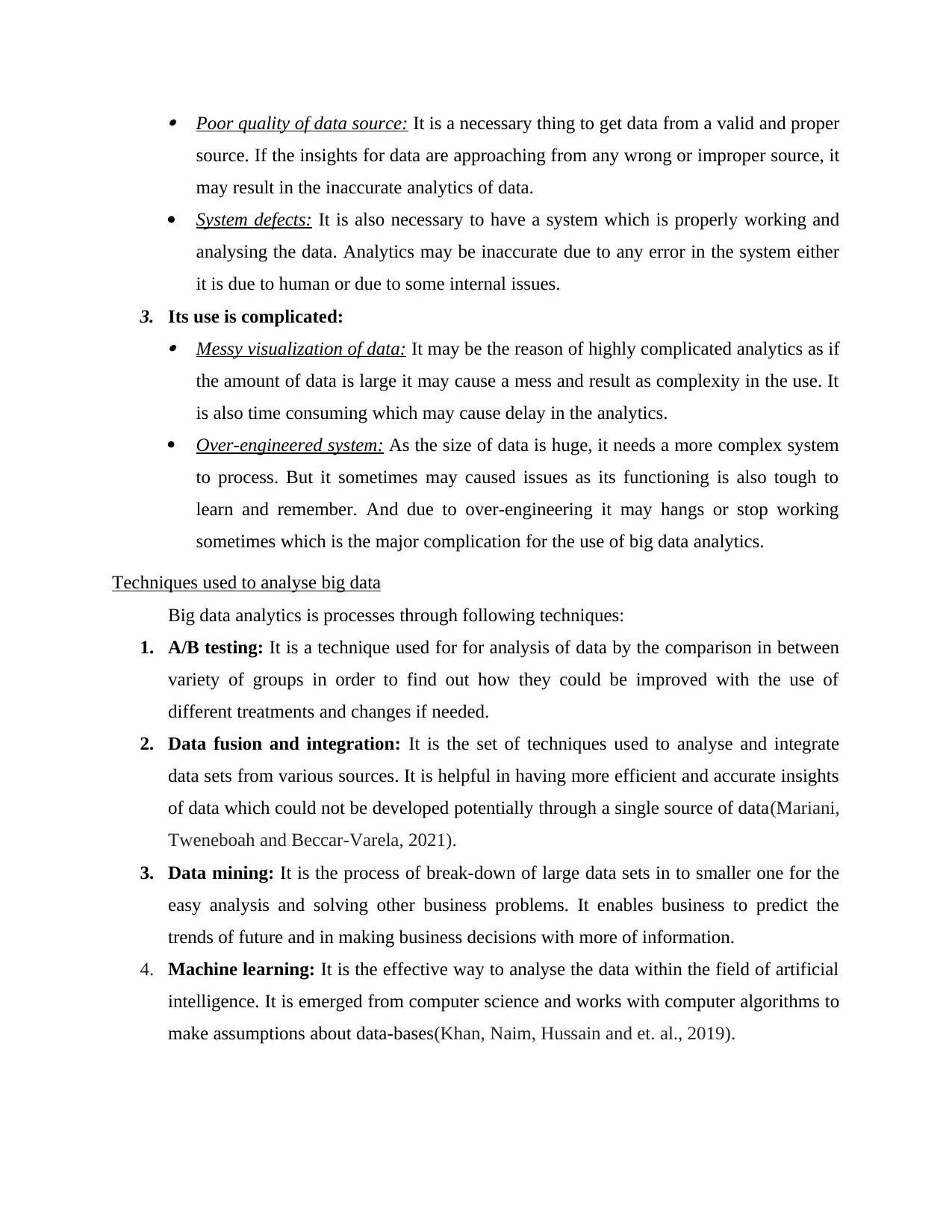
Poor quality of data source: It is a necessary thing to get data from a valid and proper
source. If the insights for data are approaching from any wrong or improper source, it
may result in the inaccurate analytics of data.
System defects: It is also necessary to have a system which is properly working and
analysing the data. Analytics may be inaccurate due to any error in the system either
it is due to human or due to some internal issues.
3. Its use is complicated:
Messy visualization of data: It may be the reason of highly complicated analytics as if
the amount of data is large it may cause a mess and result as complexity in the use. It
is also time consuming which may cause delay in the analytics.
Over-engineered system: As the size of data is huge, it needs a more complex system
to process. But it sometimes may caused issues as its functioning is also tough to
learn and remember. And due to over-engineering it may hangs or stop working
sometimes which is the major complication for the use of big data analytics.
Techniques used to analyse big data
Big data analytics is processes through following techniques:
1. A/B testing: It is a technique used for for analysis of data by the comparison in between
variety of groups in order to find out how they could be improved with the use of
different treatments and changes if needed.
2. Data fusion and integration: It is the set of techniques used to analyse and integrate
data sets from various sources. It is helpful in having more efficient and accurate insights
of data which could not be developed potentially through a single source of data(Mariani,
Tweneboah and Beccar-Varela, 2021).
3. Data mining: It is the process of break-down of large data sets in to smaller one for the
easy analysis and solving other business problems. It enables business to predict the
trends of future and in making business decisions with more of information.
4. Machine learning: It is the effective way to analyse the data within the field of artificial
intelligence. It is emerged from computer science and works with computer algorithms to
make assumptions about data-bases(Khan, Naim, Hussain and et. al., 2019).
source. If the insights for data are approaching from any wrong or improper source, it
may result in the inaccurate analytics of data.
System defects: It is also necessary to have a system which is properly working and
analysing the data. Analytics may be inaccurate due to any error in the system either
it is due to human or due to some internal issues.
3. Its use is complicated:
Messy visualization of data: It may be the reason of highly complicated analytics as if
the amount of data is large it may cause a mess and result as complexity in the use. It
is also time consuming which may cause delay in the analytics.
Over-engineered system: As the size of data is huge, it needs a more complex system
to process. But it sometimes may caused issues as its functioning is also tough to
learn and remember. And due to over-engineering it may hangs or stop working
sometimes which is the major complication for the use of big data analytics.
Techniques used to analyse big data
Big data analytics is processes through following techniques:
1. A/B testing: It is a technique used for for analysis of data by the comparison in between
variety of groups in order to find out how they could be improved with the use of
different treatments and changes if needed.
2. Data fusion and integration: It is the set of techniques used to analyse and integrate
data sets from various sources. It is helpful in having more efficient and accurate insights
of data which could not be developed potentially through a single source of data(Mariani,
Tweneboah and Beccar-Varela, 2021).
3. Data mining: It is the process of break-down of large data sets in to smaller one for the
easy analysis and solving other business problems. It enables business to predict the
trends of future and in making business decisions with more of information.
4. Machine learning: It is the effective way to analyse the data within the field of artificial
intelligence. It is emerged from computer science and works with computer algorithms to
make assumptions about data-bases(Khan, Naim, Hussain and et. al., 2019).
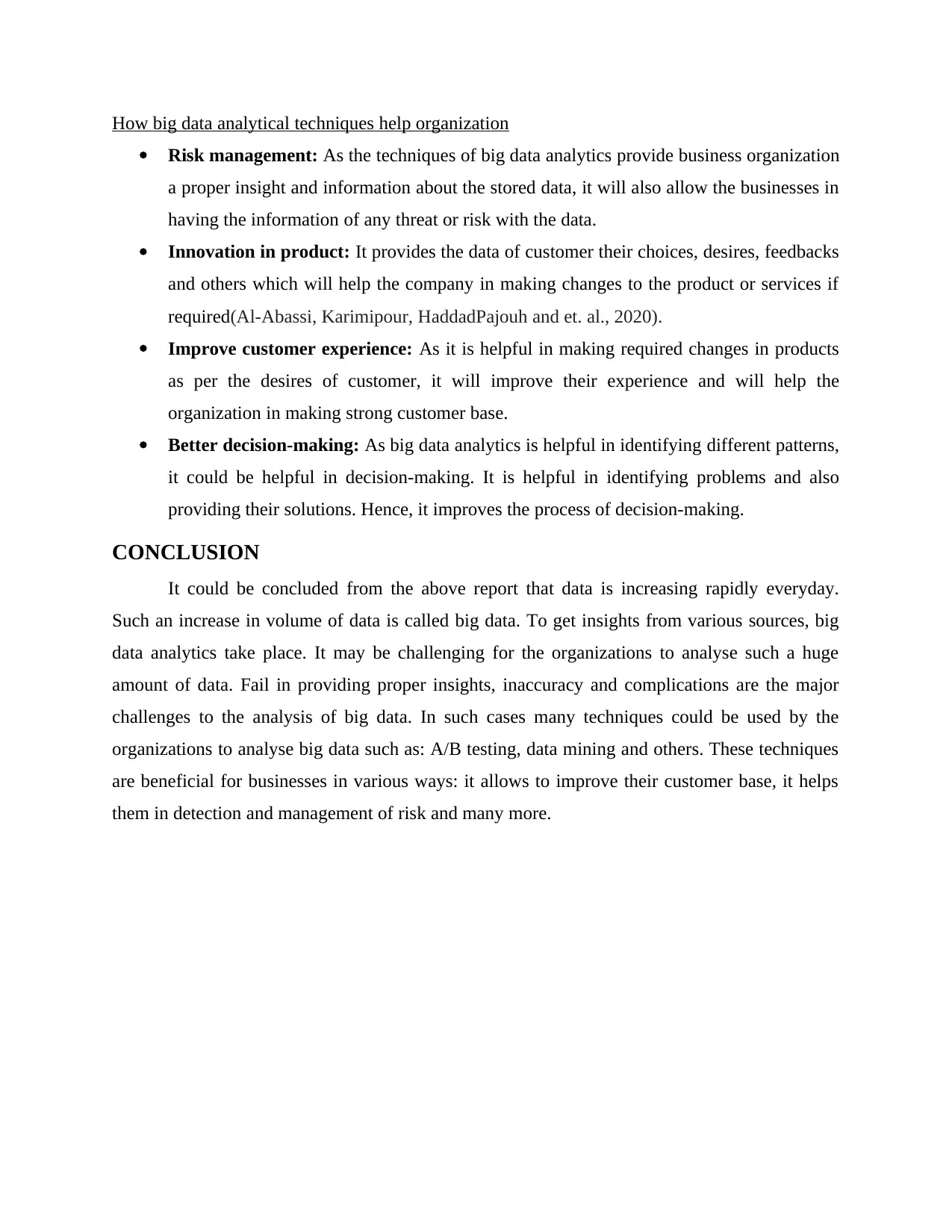
How big data analytical techniques help organization
Risk management: As the techniques of big data analytics provide business organization
a proper insight and information about the stored data, it will also allow the businesses in
having the information of any threat or risk with the data.
Innovation in product: It provides the data of customer their choices, desires, feedbacks
and others which will help the company in making changes to the product or services if
required(Al-Abassi, Karimipour, HaddadPajouh and et. al., 2020).
Improve customer experience: As it is helpful in making required changes in products
as per the desires of customer, it will improve their experience and will help the
organization in making strong customer base.
Better decision-making: As big data analytics is helpful in identifying different patterns,
it could be helpful in decision-making. It is helpful in identifying problems and also
providing their solutions. Hence, it improves the process of decision-making.
CONCLUSION
It could be concluded from the above report that data is increasing rapidly everyday.
Such an increase in volume of data is called big data. To get insights from various sources, big
data analytics take place. It may be challenging for the organizations to analyse such a huge
amount of data. Fail in providing proper insights, inaccuracy and complications are the major
challenges to the analysis of big data. In such cases many techniques could be used by the
organizations to analyse big data such as: A/B testing, data mining and others. These techniques
are beneficial for businesses in various ways: it allows to improve their customer base, it helps
them in detection and management of risk and many more.
Risk management: As the techniques of big data analytics provide business organization
a proper insight and information about the stored data, it will also allow the businesses in
having the information of any threat or risk with the data.
Innovation in product: It provides the data of customer their choices, desires, feedbacks
and others which will help the company in making changes to the product or services if
required(Al-Abassi, Karimipour, HaddadPajouh and et. al., 2020).
Improve customer experience: As it is helpful in making required changes in products
as per the desires of customer, it will improve their experience and will help the
organization in making strong customer base.
Better decision-making: As big data analytics is helpful in identifying different patterns,
it could be helpful in decision-making. It is helpful in identifying problems and also
providing their solutions. Hence, it improves the process of decision-making.
CONCLUSION
It could be concluded from the above report that data is increasing rapidly everyday.
Such an increase in volume of data is called big data. To get insights from various sources, big
data analytics take place. It may be challenging for the organizations to analyse such a huge
amount of data. Fail in providing proper insights, inaccuracy and complications are the major
challenges to the analysis of big data. In such cases many techniques could be used by the
organizations to analyse big data such as: A/B testing, data mining and others. These techniques
are beneficial for businesses in various ways: it allows to improve their customer base, it helps
them in detection and management of risk and many more.
⊘ This is a preview!⊘
Do you want full access?
Subscribe today to unlock all pages.

Trusted by 1+ million students worldwide

References
Books and Journals
Naeem, M., Jamal, T., Diaz-Martinez, J., Butt, S.A., Montesano, N., Tariq, M.I., De-la-Hoz-
Franco, E. and De-La-Hoz-Valdiris, E., 2022. Trends and future perspective challenges in
big data. In Advances in intelligent data analysis and applications (pp. 309-325).
Springer, Singapore.
Mittal, P., 2020. Big data and analytics: a data management perspective in public
administration. International Journal of Big Data Management, 1(2), pp.152-165.
Ghani, N.A., Hamid, S., Hashem, I.A.T. and Ahmed, E., 2019. Social media big data analytics:
A survey. Computers in Human Behavior, 101, pp.417-428.
Khan, N., Naim, A., Hussain, M.R., Naveed, Q.N., Ahmad, N. and Qamar, S., 2019, May. The
51 v's of big data: survey, technologies, characteristics, opportunities, issues and
challenges. In Proceedings of the international conference on omni-layer intelligent
systems (pp. 19-24).
Mariani, M.C., Tweneboah, O.K. and Beccar-Varela, M.P., 2021. Data Science in Theory and
Practice: Techniques for Big Data Analytics and Complex Data Sets. John Wiley &
Sons.
Naeem, M., Jamal, T., Diaz-Martinez, J., Butt, S.A., Montesano, N., Tariq, M.I., De-la-Hoz-
Franco, E. and De-La-Hoz-Valdiris, E., 2022. Trends and future perspective challenges in
big data. In Advances in intelligent data analysis and applications (pp. 309-325).
Springer, Singapore.
Al-Abassi, A., Karimipour, H., HaddadPajouh, H., Dehghantanha, A. and Parizi, R.M., 2020.
Industrial big data analytics: challenges and opportunities. Handbook of big data privacy,
pp.37-61.
Books and Journals
Naeem, M., Jamal, T., Diaz-Martinez, J., Butt, S.A., Montesano, N., Tariq, M.I., De-la-Hoz-
Franco, E. and De-La-Hoz-Valdiris, E., 2022. Trends and future perspective challenges in
big data. In Advances in intelligent data analysis and applications (pp. 309-325).
Springer, Singapore.
Mittal, P., 2020. Big data and analytics: a data management perspective in public
administration. International Journal of Big Data Management, 1(2), pp.152-165.
Ghani, N.A., Hamid, S., Hashem, I.A.T. and Ahmed, E., 2019. Social media big data analytics:
A survey. Computers in Human Behavior, 101, pp.417-428.
Khan, N., Naim, A., Hussain, M.R., Naveed, Q.N., Ahmad, N. and Qamar, S., 2019, May. The
51 v's of big data: survey, technologies, characteristics, opportunities, issues and
challenges. In Proceedings of the international conference on omni-layer intelligent
systems (pp. 19-24).
Mariani, M.C., Tweneboah, O.K. and Beccar-Varela, M.P., 2021. Data Science in Theory and
Practice: Techniques for Big Data Analytics and Complex Data Sets. John Wiley &
Sons.
Naeem, M., Jamal, T., Diaz-Martinez, J., Butt, S.A., Montesano, N., Tariq, M.I., De-la-Hoz-
Franco, E. and De-La-Hoz-Valdiris, E., 2022. Trends and future perspective challenges in
big data. In Advances in intelligent data analysis and applications (pp. 309-325).
Springer, Singapore.
Al-Abassi, A., Karimipour, H., HaddadPajouh, H., Dehghantanha, A. and Parizi, R.M., 2020.
Industrial big data analytics: challenges and opportunities. Handbook of big data privacy,
pp.37-61.
Paraphrase This Document
Need a fresh take? Get an instant paraphrase of this document with our AI Paraphraser
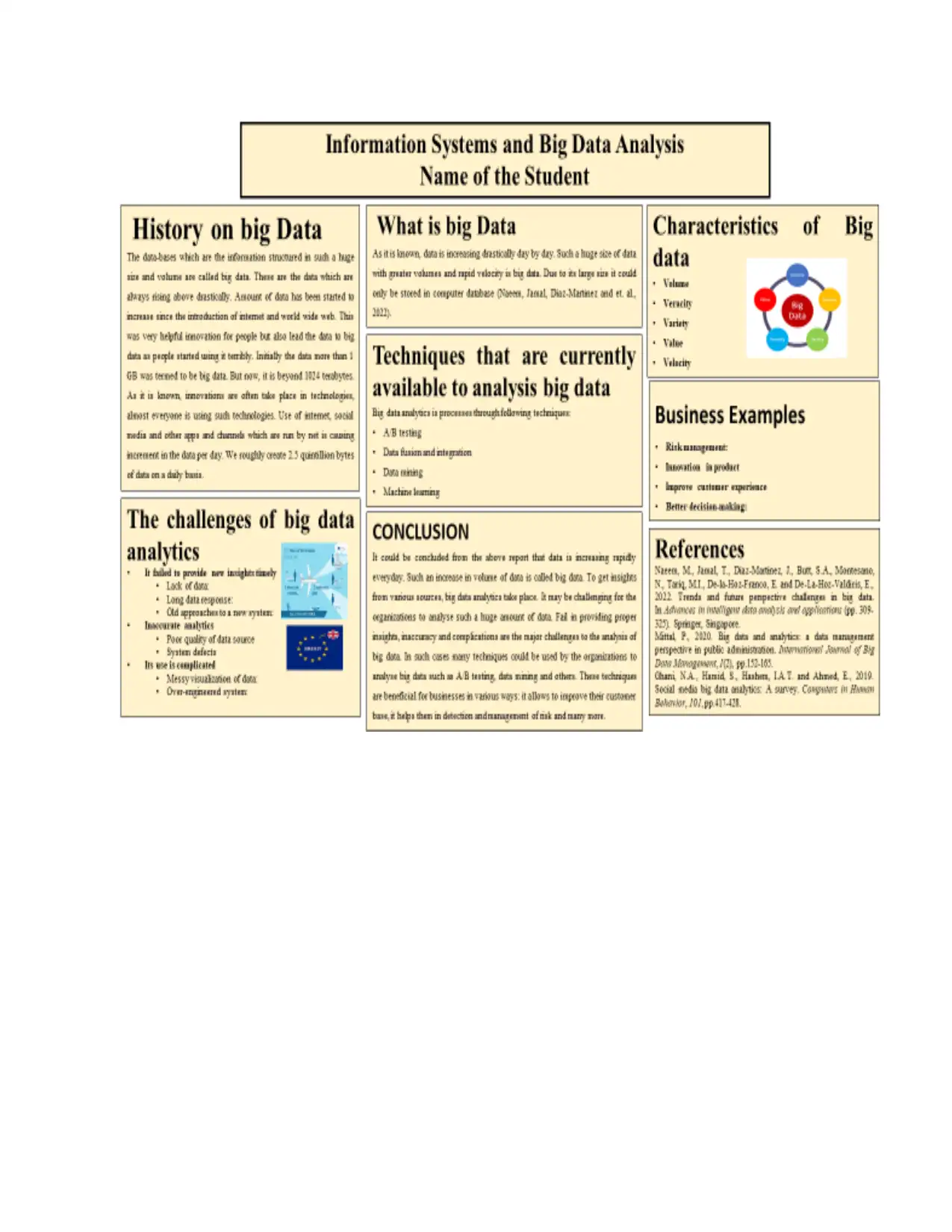
1 out of 8
Related Documents
Your All-in-One AI-Powered Toolkit for Academic Success.
+13062052269
info@desklib.com
Available 24*7 on WhatsApp / Email
![[object Object]](/_next/static/media/star-bottom.7253800d.svg)
Unlock your academic potential
Copyright © 2020–2025 A2Z Services. All Rights Reserved. Developed and managed by ZUCOL.



